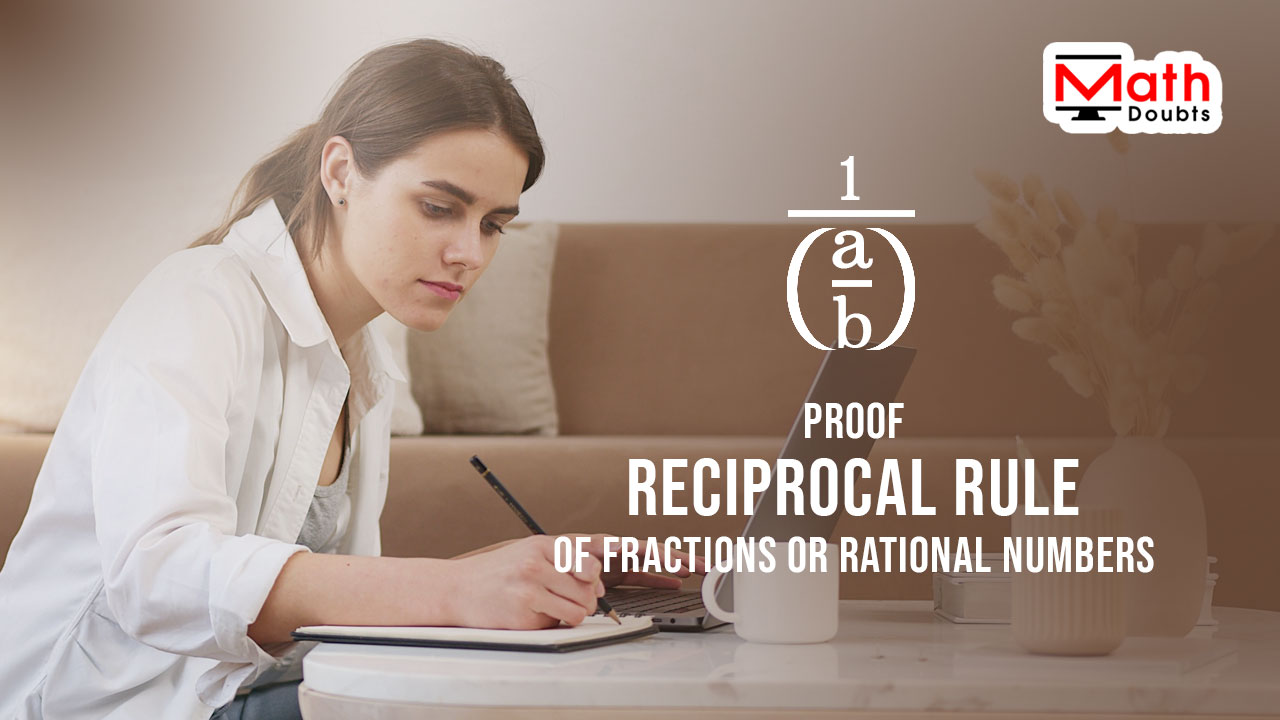
According to the reciprocal rule of fractions or rational numbers, the reciprocal of a rational number is equal to the quotient of denominator divided by the numerator of the fraction or rational number.
$\dfrac{1}{\Big(\dfrac{a}{b}\Big)}$ $\,=\,$ $\dfrac{b}{a}$
Now, let’s learn how to prove the multiplicative inverse rule of the rational numbers or fractions mathematically.
The quotient of a quantity divided by another quantity can be calculated by the division rule but the quotient of one divided by a rational number or fraction is complicated. So, it requires a special rule to find the reciprocal of a fraction or rational number. Hence, let’s denote the multiplicative inverse of rational number by a literal $y$.
$\implies$ $y$ $\,=\,$ $\dfrac{1}{\Big(\dfrac{a}{b}\Big)}$
Similarly, denote the fraction a divided by b by another variable $x$.
$\implies$ $y$ $\,=\,$ $\dfrac{1}{(x)}$
$\implies$ $y$ $\,=\,$ $\dfrac{1}{x}$
The expression on the right hand side of the equation is in rational form but the expression on the left hand side of the equation is not in fraction form. So, let’s express the literal $y$ in rational form for our convenience.
$\implies$ $\dfrac{y}{1}$ $\,=\,$ $\dfrac{1}{x}$
Now, use the cross multiply rule to eliminate the fraction form from the equation.
$\implies$ $x \times y$ $\,=\,$ $1 \times 1$
$\implies$ $x \times y$ $\,=\,$ $1$
In fact, the quotient of a divided by b is represented by a variable $x$. So, replace the literal $x$ by its actual value in the equation.
$\implies$ $\dfrac{a}{b} \times y$ $\,=\,$ $1$
Once again, a rational number or a fraction is involved on the left hand side of the equation. So, write the second factor in rational form for multiplying them.
$\implies$ $\dfrac{a}{b} \times \dfrac{y}{1}$ $\,=\,$ $1$
Now, find the product of the fractions as per the multiplication rule of the fractions or rational numbers.
$\implies$ $\dfrac{a \times y}{b \times 1}$ $\,=\,$ $1$
$\implies$ $\dfrac{a \times y}{b}$ $\,=\,$ $1$
Once again, the equation is come to the initial step. So, repeat the same procedure to find the value of literal $y$. Now, express the number one in rational form to move ahead.
$\implies$ $\dfrac{a \times y}{b}$ $\,=\,$ $\dfrac{1}{1}$
Now, use the cross multiplication formula one more time to remove the rational form from the expressions on the both sides of the equation.
$\implies$ $1 \times a \times y$ $\,=\,$ $1 \times b$
It is time to find the products of the expressions. Therefore, multiply the factors on both sides of the equation.
$\implies$ $a \times y$ $\,=\,$ $b$
The value of the variable $y$ should be calculated. So, it is time to eliminate the literal a from the left-hand side of the equation by dividing both sides of the equation with $a$.
$\implies$ $\dfrac{a \times y}{a}$ $\,=\,$ $\dfrac{b}{a}$
$\implies$ $\dfrac{a}{a} \times y$ $\,=\,$ $\dfrac{b}{a}$
$\implies$ $\dfrac{\cancel{a}}{\cancel{a}} \times y$ $\,=\,$ $\dfrac{b}{a}$
$\implies$ $1 \times y$ $\,=\,$ $\dfrac{b}{a}$
$\implies$ $y$ $\,=\,$ $\dfrac{b}{a}$
The literal $y$ is taken to represent the reciprocal of the quotient of $a$ divided by $b$. So, replace the value of $y$ but its actual value to derive the reciprocal rule of the fractions or rational numbers in mathematical form.
$\,\,\,\therefore\,\,\,\,\,\,$ $\dfrac{1}{\Big(\dfrac{a}{b}\Big)}$ $\,=\,$ $\dfrac{b}{a}$
A free math education service for students to learn every math concept easily, for teachers to teach mathematics understandably and for mathematicians to share their maths researching projects.
Copyright © 2012 - 2023 Math Doubts, All Rights Reserved